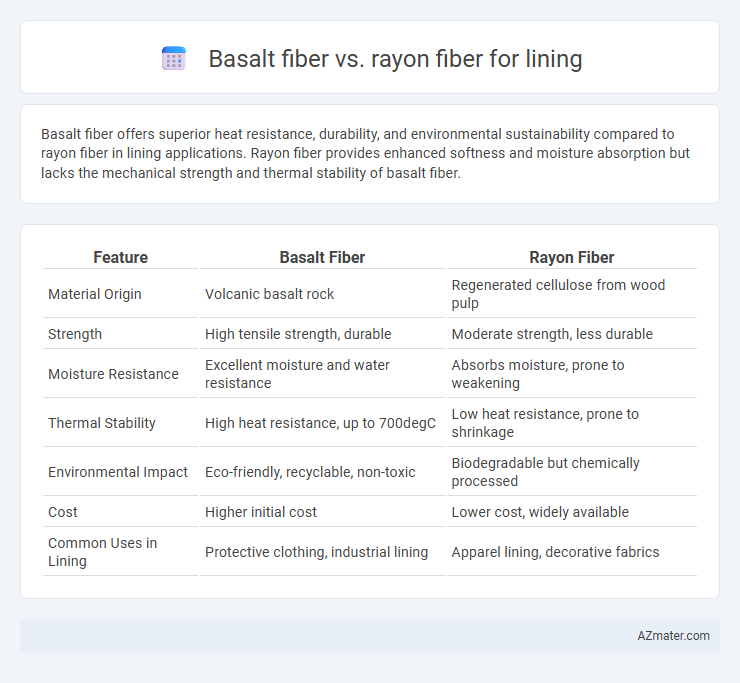Basalt fiber offers superior heat resistance, durability, and environmental sustainability compared to rayon fiber in lining applications. Rayon fiber provides enhanced softness and moisture absorption but lacks the mechanical strength and thermal stability of basalt fiber.
Table of Comparison
| Feature | Basalt Fiber | Rayon Fiber |
|---|---|---|
| Material Origin | Volcanic basalt rock | Regenerated cellulose from wood pulp |
| Strength | High tensile strength, durable | Moderate strength, less durable |
| Moisture Resistance | Excellent moisture and water resistance | Absorbs moisture, prone to weakening |
| Thermal Stability | High heat resistance, up to 700degC | Low heat resistance, prone to shrinkage |
| Environmental Impact | Eco-friendly, recyclable, non-toxic | Biodegradable but chemically processed |
| Cost | Higher initial cost | Lower cost, widely available |
| Common Uses in Lining | Protective clothing, industrial lining | Apparel lining, decorative fabrics |
Introduction to Basalt Fiber and Rayon Fiber
Basalt fiber, derived from volcanic basalt rock, offers high thermal resistance, durability, and eco-friendly properties ideal for industrial lining applications. Rayon fiber, a semi-synthetic cellulose-based fiber, provides softness, flexibility, and moisture absorption but has lower heat resistance and mechanical strength compared to basalt. Choosing between basalt and rayon fiber for lining depends on specific performance needs such as thermal stability and durability versus comfort and moisture management.
Composition and Manufacturing Processes
Basalt fiber, derived from volcanic rock, is produced by melting basalt stones at temperatures around 1,400degC and extruding the molten material into fine fibers, resulting in high thermal resistance and mechanical strength. Rayon fiber, a semi-synthetic cellulose fiber made from purified wood pulp, undergoes chemical treatment and regeneration through the viscose process, forming a soft, breathable lining material. The inorganic, mineral-based composition of basalt fibers offers superior durability and heat resistance compared to the organic, moisture-absorbent nature of rayon fibers commonly used for comfort in linings.
Mechanical Properties Comparison
Basalt fiber exhibits significantly higher tensile strength, often ranging between 2,800 to 4,800 MPa, compared to rayon fiber, which typically has tensile strengths around 400 to 600 MPa. The modulus of elasticity for basalt fiber is approximately 85 to 110 GPa, surpassing rayon's modulus of 10 to 12 GPa, indicating superior stiffness and load-bearing capacity in basalt fiber linings. Additionally, basalt fiber offers better thermal stability and abrasion resistance, making it more suitable for high-performance mechanical applications than rayon fiber.
Thermal Resistance and Heat Tolerance
Basalt fiber exhibits superior thermal resistance and heat tolerance compared to rayon fiber, withstanding temperatures up to 650degC without significant degradation, whereas rayon fiber typically endures only around 200degC before losing structural integrity. This makes basalt fiber ideal for lining applications exposed to high temperatures, providing enhanced fire resistance and durability. Rayon fiber, derived from cellulose, lacks the thermal stability necessary for extreme heat environments, limiting its use to lower temperature scenarios.
Durability and Longevity in Lining Applications
Basalt fiber exhibits superior durability and longevity compared to rayon fiber in lining applications due to its high resistance to heat, chemical corrosion, and mechanical wear. Basalt fibers maintain structural integrity under extreme conditions, making them ideal for industrial and high-performance lining uses. Rayon fiber, while flexible and cost-effective, generally degrades faster when exposed to moisture and abrasive environments, resulting in shorter service life.
Chemical Resistance and Environmental Performance
Basalt fiber exhibits superior chemical resistance compared to rayon fiber, with high stability against acids, alkalis, and solvents, making it ideal for harsh lining environments. Rayon fiber, derived from cellulose, is more susceptible to degradation and chemical damage, limiting its use in chemically aggressive applications. Environmentally, basalt fiber is sustainable, produced from abundant volcanic rock with low energy consumption and minimal waste, whereas rayon fiber involves intensive chemical processing and deforestation concerns.
Cost Analysis and Economic Considerations
Basalt fiber offers superior durability and thermal resistance compared to rayon fiber, leading to longer lifespan and reduced maintenance costs in lining applications. While rayon fiber may have a lower initial material cost, the frequent replacement requirements and inferior mechanical properties increase total lifecycle expenses. Economic considerations favor basalt fiber for high-performance linings due to its cost-effectiveness over time despite higher upfront investment.
Sustainability and Environmental Impact
Basalt fiber offers superior sustainability compared to rayon fiber due to its natural origin from volcanic rock, requiring minimal chemical processing and generating less environmental pollution. Rayon fiber production involves intensive use of chemicals and water, leading to significant environmental degradation and higher carbon emissions. Basalt fiber's durability and recyclability contribute to a lower overall carbon footprint, making it a more eco-friendly choice for lining applications.
Common Applications in Lining Materials
Basalt fiber offers superior heat resistance and durability, making it ideal for high-temperature lining applications in industrial furnaces and heat exchangers. Rayon fiber provides excellent moisture absorption and softness, commonly used in comfort-focused linings such as apparel and upholstery. Both fibers cater to different functional requirements, with basalt favored for thermal insulation and rayon preferred for comfort and breathability.
Conclusion: Choosing the Ideal Fiber for Lining
Basalt fiber offers superior thermal resistance, durability, and environmental sustainability compared to rayon fiber, making it ideal for high-performance lining applications. Rayon fiber provides excellent softness and moisture absorbency but lacks the strength and heat resistance required for demanding environments. Selecting basalt fiber ensures enhanced longevity and protection, while rayon suits comfort-focused linings in less extreme conditions.

Infographic: Basalt fiber vs Rayon fiber for Lining
 azmater.com
azmater.com